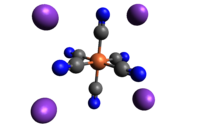Potassium ferrocyanide
 |
|
 |
|
 |
|
| Names | |
|---|---|
|
IUPAC name
Potassium hexacyanidoferrate(II)
|
|
| Other names
(Yellow) Prussiate of Potash,
Potassium hexacyanoferrate (II) trihydrate, Tetrapotassium ferrocyanide trihydrate, Ferrate hexacyano tetrapotassium trihydrate |
|
| Identifiers | |
|
|
| ECHA InfoCard | 100.034.279 |
| E number | E536 (acidity regulators, ...) |
|
PubChem CID
|
|
| Properties | |
| K4[Fe(CN)6] | |
| Molar mass | 368.35 g/mol (anhydrous) 422.388 g/mol (trihydrate) |
| Appearance | Light yellow, crystalline granules |
| Density | 1.85 g/cm3 (trihydrate) |
| Boiling point | (decomposes) |
|
trihydrate 28.9 g/100 mL (20 °C) |
|
| Solubility | insoluble in ethanol, ether |
| −130.0·10−6 cm3/mol | |
| Hazards | |
| R-phrases | R32, R52, R53 |
| S-phrases | S50(B), S61 |
| NFPA 704 | |
| Flash point | Non-flammable |
| Lethal dose or concentration (LD, LC): | |
|
LD50 (median dose)
|
6400 mg/kg (oral, rat) |
| Related compounds | |
|
Other anions
|
Potassium ferricyanide |
|
Other cations
|
Sodium ferrocyanide Prussian blue |
|
Except where otherwise noted, data are given for materials in their standard state (at 25 °C [77 °F], 100 kPa).
|
|
|
|
|
| Infobox references | |
Potassium ferrocyanide is the inorganic compound with formula K4[Fe(CN)6] · 3H2O. It is the potassium salt of the coordination complex [Fe(CN)6]4−. This salt forms lemon-yellow monoclinic crystals.
Potassium ferrocyanide is produced industrially from hydrogen cyanide, ferrous chloride, and calcium hydroxide, the combination of which affords Ca2[Fe(CN)6] · 11H2O. This solution is then treated with potassium salts to precipitate the mixed calcium-potassium salt CaK2[Fe(CN)6], which in turn is treated with potassium carbonate to give the tetrapotassium salt.
Historically, the compound was manufactured from organically derived nitrogenous carbon sources, iron filings, and potassium carbonate. Common nitrogen and carbon sources were torrified horn, leather scrap, offal, or dried blood.
Treatment of potassium ferrocyanide with nitric acid gives H2[Fe(NO)(CN)5]. After neutralization of this intermediate with sodium carbonate, red crystals of sodium nitroprusside can be selectively crystallized.
Upon treatment with chlorine gas, potassium ferrocyanide converts to potassium ferricyanide:
This reaction can be used to remove potassium ferrocyanide from a solution.
A famous reaction involves treatment with ferric salts to give Prussian blue. With the approximate composition KFe2(CN)6, this insoluble but deeply coloured material is the blue of blueprinting.
Potassium ferrocyanide finds many niche applications in industry. It and the related sodium salt are widely used as anticaking agents for both road salt and table salt. The potassium and sodium ferrocyanides are also used in the purification of tin and the separation of copper from molybdenum ores. Potassium ferrocyanide is used in the production of wine and citric acid.
...
Wikipedia

